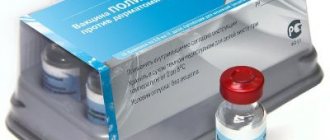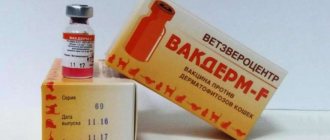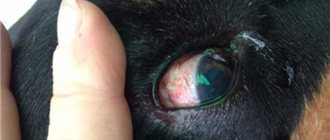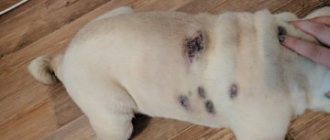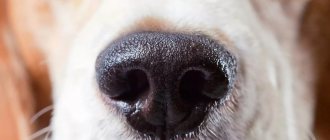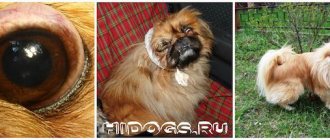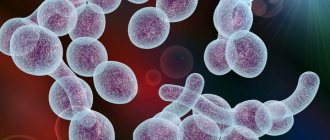Fungus in dogs, or more correctly mycosis, is a relatively uncommon phenomenon. It is very important not to start the painful process, make a diagnosis in time and begin treatment. Otherwise, recovery will take many months.
Fungus or mycosis is a disease caused by a group of pathogenic fungi. These can be molds, yeasts or yeasts.
The most famous fungal disease is lichen (dermatophytosis or dermatomycosis). However, in addition to this common disease, there are many other fungal pathologies.
Mycoses affect not only the skin, but also mucous membranes and can even be systemic, i.e. affect internal organ systems.
Types of mycoses and their locations
Fungal diseases can be classified in different ways. From a clinical point of view, the localization of mycosis and the specific type of pathogen are important. The main mycoses that affect dogs:
Dermatomycosis
Better known as lichen. The causative agents are Microsporum canis, Microsporum gypseum and Trichophyton mentagrophytes. As a rule, this disease affects the skin. These damages can vary in degree, depending on the dog’s immunity and the stage of neglect of the process.
Aspergellosis
A disease caused by mold fungi of the genus Aspergillus. It occurs not only in dogs, but also in cats, farm animals, birds, and very often in humans.
Comes in two forms:
Sinonasal aspergillosis . Most often found in this form. A lot of nasal diseases develop precisely because of this fungus. The causative agent of nasal aspergillosis is Aspergillus fumigatus. A distinctive feature is that most often this pathology occurs in young dogs with a medium or long muzzle.
The main signs of sinonasal mycosis:
- mucopurulent discharge from the nose;
- frequent sneezing;
- the dog experiences discomfort in the nasal cavity, at the same time pain and itching;
- minor nosebleeds;
- depigmentation on the nose (loss of color);
- ulcers may appear in place of depigmented areas;
- deterioration of general condition, lethargy, loss of appetite.
If the disease is neglected, the mycosis can reach the brain and then we can observe convulsions in the dog.
Systemic aspergillosis . In this case, the process affects both the lungs and the nervous system. This form is most typical for German Shepherds. Symptoms in this case are nonspecific:
- pneumonia;
- depression;
- convulsions and paralysis;
- sudden weight loss;
- increased temperature - fever;
- damage to internal organs, for example, if the kidneys are affected, then blood is found in the urine.
Candidiasis
Causes a pathogenic fungus of the genus Candida. This disease is popularly called thrush. The fungus can affect both the skin and mucous membranes. It is often found in the ears, in the oral and nasal cavities, as well as on the mucous membranes of the genital organs.
Symptoms:
- red lesions, erosions, peeling on the skin;
- if the oral mucosa is affected, excessive salivation and ulcers;
- if the nose is affected - inflammation of its mucous membrane (rhinitis);
- fungal conjunctivitis is manifested by lacrimation and cheesy purulent discharge from the eyes;
- photophobia;
- in the vaginal form - curdled mucous discharge from the genitals;
- itching
Blastomycosis
A disease caused by the yeast-like fungus Blastomyces. It is more common in dogs than in other animal species. NOT INFECTIOUS. This fungus lives in damp places, often in decaying foliage. The infection enters the body through the respiratory tract and affects organ systems. It occurs in two forms:
System . Internal organs are affected and subcutaneous tumors appear. In this form, blastomycosis acts as a malignant fungus. The prognosis is unfavorable. Main symptoms:
- dyspnea;
- frequent cough;
- fever;
- osteomyelitis, joint swelling;
- eye lesions;
- deterioration of general condition.
Cutaneous . Usually proceeds quite easily:
- the appearance of abscesses on the skin;
- nodules on the skin;
- itching
Malasesia
A disease caused by yeast fungi of the genus Malassezia. These fungi are classified as conditionally pathogenic, since they live on the skin of dogs normally, without causing any harm to health.
Under certain conditions, they begin to multiply quickly and cause dermatitis. In other words, Malassezia dermatitis usually develops against the background of another disease.
The spaces most often affected are the spaces between the fingers, folds of the lips, claws, ears and armpits. Places where sweating is increased or which are often damp. Characteristic features:
- the skin develops a very characteristic sweetish odor;
- claws turn brown;
- if the fungus is localized in the ears, then brown discharge from the ear is characteristic;
- the skin itself becomes thickened and oily (with an oily sheen and greasy);
- itching
The most common mycoses are listed above, but there are others, cases of which in dogs are rare in Russia, for example:
Histoplasmosis
A very small mushroom of the genus Histoplasma capsulatum. If it occurs, it is usually in hunting dogs. It enters the body through the respiratory tract, affects the lungs, and then the gastrointestinal tract.
Symptoms are nonspecific:
- weight loss;
- fever;
- enlarged lymph nodes;
- damage to internal organs, including hepatomegaly (enlarged liver);
- the nervous system is affected.
Cryptococcosis
Caused by yeast-like fungi Cryptococcus neoformans and Cryptococcus gattii. Very often they live in pigeon droppings. Infection occurs through the respiratory tract. This disease occurs in dogs, but even humans are affected more often.
Affected:
- respiratory system. The nasal mucosa is often affected;
- eyes, then we see keratoconjunctivitis and other pathologies. It can lead to blindness, but this is due to damage to the central nervous system;
- leather. Rare, as this fungus does not grow if the temperature is above 37 degrees. Therefore, skin lesions usually occur on the nose, ears, scrotum (in general, where the temperature is colder relative to the rest of the body);
- central nervous system. These are convulsions, meningitis is possible.
Coccidioidomycosis
The disease is usually observed in places with dry, hot climates. The fungi themselves are large, and their spores are small. As in other cases, infection is primarily through the respiratory tract.
Symptoms are nonspecific:
- temperature rise to 41 degrees;
- pneumonia;
- weight loss;
- bone lysis;
- eye damage.
Answers on questions
I have analyzed the most frequently asked questions from dog breeders on the topic of this article and will try to answer them.
What types of fungus can a person get infected from a pet?
Causative agents of Trichophytosis and Microsporia.
How to protect yourself from infection when caring for a sick dog?
When applying external medications, as well as giving tablets, you should wear disposable gloves, which are destroyed after use. Hands and open areas of the body are washed with soap and washed.
What dog breeds are predisposed to fungal diseases?
First of all, animals exposed to unfavorable environmental conditions: service and hunting animals. Decorative dogs, often short-faced ones, are also not protected from infection. They live in comfortable conditions, but can become infected while walking through contact with wild relatives or objects that have come into contact with a sick dog. These are the costs of directed selection, in which desirable traits arise due to weakening of the immune system.
Has a vaccine been developed against Malasseziasis?
Russian veterinary pharmaceuticals produce vaccines only against Microsporia and Trichophytosis.
Causes and routes of infection
Fungal diseases always develop against the background of reduced immunity.
This can be facilitated by:
- other diseases;
- immunodeficiencies;
- diabetes;
- pregnancy;
- puppies may have reduced immunity;
- unfavorable conditions of detention.
Also, constant dampness is an auxiliary factor for the development of fungal infection.
Since infection occurs primarily through inhalation of pathogens, if the dog has previously had respiratory tract infections, this may serve as an additional factor for infection.
How to treat fungal diseases
The treatment strategy is developed in the following areas:
- Provide comfortable living conditions. Isolate your pet and provide it with a comfortable, warm rookery.
- Transfer the patient to veterinary feeding for dogs with skin diseases. Eliminate treats with human treats, as well as table scraps.
- Provide your veterinarian with medication prescriptions. The initial stage is external antimycotics with a wound healing effect. If treatment does not bring the expected result, use oral or parenteral medications.
I have selected popular antifungal drugs for dogs. A list of medications, their description and cost are provided in the next section of the article.
Risk group
Fungal diseases, with the exception of dermatomycosis, are not very common in Russia, so the likelihood of infection is not high. But there is a breed predisposition.
Systemic aspergillosis is more common in German Shepherds, and sinonasal aspergillosis is more common in any dog with a medium or long muzzle.
West Highland White Terriers, German Shepherds, Basset Hounds, Shih Tzus, Dachshunds, Boxers and Poodles are genetically predisposed to mallasesial dermatitis.
Histoplasmosis mainly occurs in hunting dogs.
Symptoms of fungal infection in dogs
The first thing that catches your eye with mycoses is a change in the condition of the skin and coat. The following factors should alert the owner:
- the animal experiences severe itching, often scratches, licks and bites some area (not always);
- the dog's hair falls out or breaks off, bald spots and bald patches form;
- the skin in the affected area becomes dry, peels, and takes on an unhealthy color;
- an unpleasant odor emanates from the skin;
- if the ears are affected, they swell, the inner surface turns red and swells, and a large amount of wax is released;
- in the case of interdigital dermatitis, the skin on the paws (between the toes) cracks, turns red and changes color.
Only a veterinarian can determine which fungal disease these symptoms refer to, with the help of additional research.
Diagnostics
Diagnostics includes several stages. And it must be carried out in a veterinary clinic.
To begin with, laboratory tests are carried out:
- It is necessary to donate blood, and in some cases, urine (for the presence of antigens), for analysis.
- The affected part of the skin or mucous membrane is sent for cytology. For dermatophytosis, scraping is done.
- Sowing for fungi.
- With the sinonasal form of the course, rhinoscopy is necessary to assess the condition of the nasal mucosa.
- In some cases, when bone lysis is suspected, an X-ray or CT scan with contrast is necessary.
- You won’t be able to make and confirm the diagnosis yourself at home, so in any case you need to contact a specialist.
Prevention
Avoiding fungal infections in your pet is easier than treating the pathology. It is enough to follow simple preventive recommendations:
- Keep your pet's enclosure clean and regularly wash its bedding if it lives in an apartment.
- Isolate the dog from contact with stray animals that may be carriers of infection.
- Bathe your pet on a schedule; do not wash it with special shampoos more often than recommended by your veterinarian.
- Provide good living conditions for your four-legged friend. Don't overload him with training.
- Visit the veterinarian in a timely manner with your pet. If signs of various diseases appear (even if they look like minor damage to the skin or mucous membranes), begin treatment immediately. Vaccinate and deworm the animal according to schedule.
The dog breeder also needs to monitor the state of his dog’s immunity. If signs of vitamin deficiency appear, the animal owner should contact a veterinarian, select vitamins for the dog and give them strictly according to schedule. By following these simple rules, you can avoid mycosis in your pet.
Treatment
Treatment should be prescribed by a veterinarian after a full diagnosis. Since sometimes only local treatment is sufficient, in other cases the use of systemic drugs is required, and sometimes surgery cannot be avoided.
However, local treatment always takes place as it gives the greatest effectiveness.
For topical use, of all antifungal agents, clotrimazole cream is most often used. Clotrimazole effectively fights both yeast and mold fungi, and is also active against dermatophytes.
This is an effective and beneficial remedy. However, you should not prescribe it yourself and it is better to use it under the supervision of a veterinarian. Possible side effects from its use:
- irritation of skin and mucous membranes;
- refusal to eat;
- salivation.
Another option for an antifungal agent for external use is Enilconazole (as part of the drug “Imaverol”). It is active against the same fungi as clotrimazole, but is less toxic. The price may be more expensive than the first option.
In addition to local antifungal agents, systemic ones are used.
Itraconazole is a drug available in the form of tablets and capsules. Active against the same fungi, but does not act against candidiasis
Cannot be used without prescription from a specialist.
In addition to drug treatment, special procedures may be needed. For example, with the sinonasal form of mycosis (when the nasal mucosa is affected), rhinoscopy may be necessary for therapeutic purposes. A rather complex procedure is performed, for which the dog must be put to sleep.
Using rhinoscopy, the airways are cleared, and then the nose is washed using special catheters.
In other cases, especially when bone lysis has begun, surgical intervention is necessary, since direct access to the affected parts is required.
In addition, symptomatic therapy is necessary. For example, painkillers or anticonvulsants, if the central nervous system (CNS) is affected.
For fungal infections, it is necessary to take a very responsible approach to treatment, as it requires a lot of time.
Typically, the first results of therapy are visible within one to two weeks. But it’s too early to rejoice; sometimes treatment is delayed for a year or even more.
The peculiarity of mycoses is that relapses occur very often.
Owner stories
Evgeniya : “We bought a puppy from breeders. We didn’t go outside, the baby stayed at home all the time. After some time, the dog developed a rash in the chest area that did not go away. We smeared it with green paint and gave it suprastin. There was no improvement and we went to the doctor. By that time, the neck, chest and groin were covered in small plaques. First, scrapings were taken from the puppy, but nothing was found in them. Then the doctor said that a culture still needed to be done. As a result, it turned out that it was ringworm. The doctor prescribed me to take terbinafine tablets and wash with shampoo. After a month and a half, the skin was completely clean and there was no fungus after re-seeding.”
Vladimir : “I was going on vacation and I had to leave my dog at the pet hotel. I was gone for 10 days. After picking up the dog, after a while I noticed some bald patches on her face and nails. On her paws she licked them all the time. I tried putting antibiotic ointment on it, but the spots kept getting bigger. I took the dog to the doctor. They did a scraping and a special culture. When the tests were ready, the doctor said that it was all due to a fungus, which the dog most likely picked up at the pet hotel. The doctor prescribed pills for my dog, which I gave her for more than 2 months. We also washed ourselves with medicated shampoo. Everything completely went away only after 3 months.”
Briefly about the main thing
- Fungus or mycosis is a disease not only of dogs, but of many other animals and even humans, which is caused by pathogenic fungi.
- Mycoses always develop against the background of decreased immunity.
- There are many types of pathogenic fungi, which can be divided into: dermatophytes (lichen), yeast-like fungi and yeasts, molds.
- Fungi are mainly contracted by inhalation.
- Local treatment is more effective than tablets.
- The treatment process can drag on for a very long time, so you need to approach it responsibly.
Have we answered your question fully enough? If not, post your question in the comments below and our veterinarian will answer it.
Did you like the article? Share it with your friends on social media. networks. This will help them get useful information and support our project.
conclusions
Fungal diseases occur when the immune system is weakened under the influence of unfavorable environmental factors, improper care, inadequate feeding, as well as congenital predisposition.
Do not violate sanitary and hygienic rules for caring for infected animals so as not to become infected yourself. If patches of alopecia appear, use external remedies. If additional pathological symptoms occur, seek veterinary attention. Do not weaken your pet's immune system with human delicacies and table scraps.
Watch the video:
